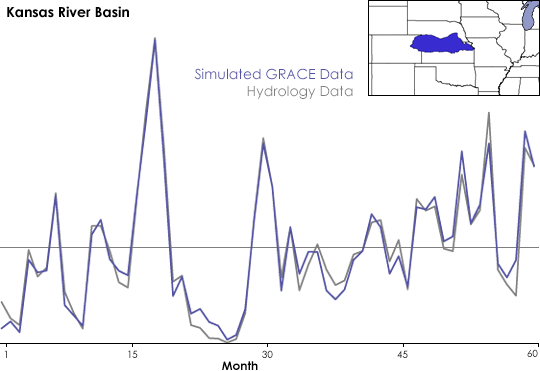

 |
|||
| Set against the velvet blackness of outer space, our home planet looks like a “blue marble”—bright, shimmering, and mostly fluid. Indeed, it is the abundance of water on its surface that gives Earth its blue appearance. Water covers approximately 70 percent of our world’s surface. So it would seem that finding water is a trivial task. Yet only 2.5 percent of the Earth’s water is fresh and thus suitable for consumption. Not only that, but of that 2.5 percent, more than two-thirds is locked away in glaciers and not particularly able to help meet the growing demands of society. By far, the most abundant and available source of fresh water is underground water supplies or wellsprings known as aquifers. Therefore, scientists and natural resource managers are very interested in tracking how these underground reservoirs of fresh water are changing with time. Launched in 2002, a pair of identical satellites that make up NASA’s
Gravity Recovery And Climate Experiment (GRACE) are tackling the problem
in an unexpected way: they are weighing Earth’s fresh water from
space. Serving as a sort of “divining rod” in space that
moves in response to a powerful, fundamental force of nature—gravity—the
satellites respond to changes in Earth’s gravitation field that
signal shifts in the movement of water across and under Earth’s
surface. |
|
||
 |
 |
||
John Wahr, research scientist at the University of Colorado, pioneered this new technique in 1998, working with the GRACE team, by creating a computer simulation of what he thought the Earth’s gravity field would look like to the GRACE mission. He divided the total gravity field into its separate components, estimating how much of the signal came from the oceans, landmasses, atmosphere, and subsurface water. Next, he subtracted off the other components of the gravity field and deduced how much of the total gravity signal was caused by underground water. |
Using simulated GRACE data, John Wahr demonstrated that month-to-month water storage changes could be retrieved from space. The graph above shows how well simulated GRACE retrievals (green line) compare to actual hydrological model data (gray line) in the Mississippi River Basin (area shown in green in map inset). (Graph by Alex McClung based on data from John Wahr.) | ||
 |
 |
||
“The idea was to see if I could recover [underground] water storage from simulated GRACE data, in the presence of all the other signals [in Earth’s gravity field],” Wahr explains. Encouraged by the experiment, Wahr and his colleagues believe that GRACE will be able to detect subsurface water and they look forward to testing the theory now that GRACE data are being collected. Can these data be used to monitor changes in underground water over time? How precise will GRACE’s measurements be? Over how small an area can this technique be used effectively? |
The graph above shows how well simulated water storage retrievals from GRACE (blue line) match up with actual hydrological model data (gray line) for an aquifer in northern Kansas, southern Nebraska, and eastern Colorado (area shown in blue on map inset). GRACE is much more sensitive to water storage changes over a large area like the Mississippi River Basin than it is over a smaller area; the two lines on the Mississippi River Basin graph follow each other more closely than do the lines on the graph above. (Graph by Alex McClung based on data from John Wahr.) | ||